Piazza Augusto Imperatore
1938 Pavillion
Mussolini's decision to clear all buildings surrounding the Mausoleum, except churches, led to the destruction of large residential blocks surrounding the Mausoleum, including those on the land between the Mausoleum and the avenue beside the Tiber embankment. On this narrow piece of land, Mussolini decided to locate a new pavilion to house the reconstructed Ara Pacis Augustae. Although the architect entrusted with the design of the pavilion, Vittorio Ballio Morpurgo, considered other locations, including some at lower levels nearer the Mausoleum, Mussoline's decision was based on the added prestige that this prominent position would ensure the Ara Pacis.
Murpurgo's design, though compromised by time and budget restrictions, was simple, classical, and elegant. To some extent, the 2 entrance facades of the pavilion reflected the 2 front facades of the Ara Pacis. As a single purpose structure, it provided a dignified setting for the monument, and allowed one to approach the monument from either of its 2 fronts, as in its original setting on the Campus Martius.
At the last minute, decisions were turned over to a committee of engineers, who eliminated Morpurgo’s elegant spacing of the piers (see Rossini, 2007, p.114). Originally intended to be built of glass and marble, the pavilion was constructed hurridly and cheaply of glass, concrete and fake porphyry. It provided limited protection from urban polution, the severe temperature changes in Rome, and other environmental factors. The side windows provided generous light but the ceiling was dark and low.
A Sept. 28, 1938 newsreel, from the Instituto Luce - Cinecittà, “L'inaugurazione dell'Ara Pacis nel nuovo assetto urbanistico”, is on the web through YouTube. This shows the official arrival of Mussolini and other officials, accompanied by Moretti, for the rededication of the Ara Pacis Augustae in its new pavilion, as part of the closing ceremony of the Augustan Year, the 2000 year anniversary of Augustus' birth. The newsreel includes exterior and interior views of the pavilion, with details of the newly reconstructed Ara Pacis.
Because of severe deterioration, on the initiative of the Rotary Club Rome, the pavilion was to some extent restored in 1970-1971, largely consisting of the installation of entirely new glass windows. However, the building continued to deteriorate and, during the 1990s, it became clear that major action was needed if the Ara Pacis itself was to be preserved.
TO ZOOM IN ON THE LARGE IMAGES, USE THE BUTTONS AT TOP-LEFT.
Tips for using this website
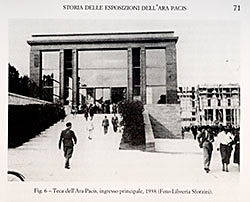
"Fig. 6-Shrine of the Ara Pacis, main entrance, 1938 (photo Libreria Sforzini)". Simplified reliefs of fasces can be seen More realistic images of fasces http://www.reed.edu/ara-pacis/meier/piazza-augusto-imperatore/fabbricato%20B1/ Foto Libreria Sforzini Scanned from Gobbi, 2003.
|
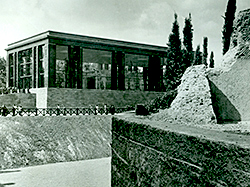
1938 photo following clearing of the area around the mausoluem and opening of the museum, showing the Ara Pacis within the pavilion. American Academy in Rome, Photographic Archive, Fototeca Unione 22926. Reproduced with appreciation.
|
View of the east side of the pavilion and of the stairs and entrance at the north end. The photos to the left show the same east side wall but show the opposite stairs and entrance at the south end. Scanned from ItalicOne website.
|
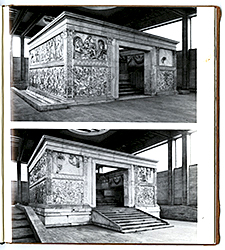
ca. 1965. These 2 photographs show the Ara Pacis after removal in 1945 of its WWII anti-shrapnel wall and after the lower portions of the original glass wall areas had been fitted with fake travertine walls. Scanned from Simon, 1968, pl.I.
|
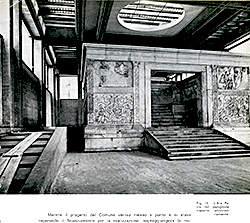
"Fig. 10. The Ara Pacis in the hall temporarily reopened." Scanned from Gatti, 1970, fig.10 - Pugliese, 1970. Reproduced with appreciation.
|
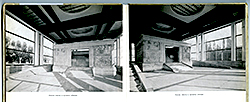
1970. "View of restoration of the interior". Scanned from Gatti, 1970 - Pugliese, 1970, pp.54-55. Reproduced with appreciation.
|
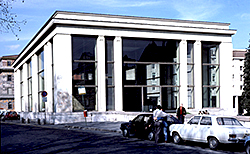
1987. South front from the Lungotevere in Augusta. In 1970 the defective windows were replaced, again allowing more light into the pavilion. One can see that in 1987 the street crowded the pavilion even more closely then today. photo April 1987
|
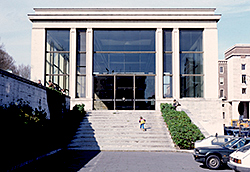
1987. South front of pavilion, showing the wall separating the major avenue to its left from the area in front of museum. In the new museum, this parking space has been transformed into a plaza, expansive stairs, and fountain. photo April 1987
|
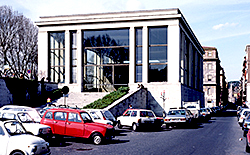
1987. South front from the Via di Ripetta, the area in front of the museum used partly for parking. This street has now been largely returned to a pedestrian area, as in 1938. photo April 1987
|